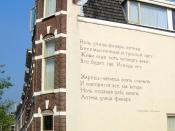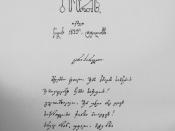For its structure, the poem is written as a single, unbroken verse, without any punctuation except a few full stops. This is to make it feel like an angry 'rant' (outburst).
The lines are short - including one two-word line: 'thi trooth' - to emphasise the key points, and to make the poem aggressive and 'direct'.
The lines are written as they would be on an autocue, which is a visual reference to TV newsreaders, but the fact that they are laid out in a long narrow line may also show that the poet feels that he is being limited and constricted by society because of the way he talks.
In its use of language, the poem is a phonetic version of Tom Leonard's own Glaswegian dialect. It says: 'Yi widny wahnt', not 'you would not want', and: 'If a toktaboot' instead of: 'if I talked about'.
This has the effect of making the poem very aggressive and 'in your face' with its message. It also reflects Leonard's pride in his background and Scottish dialect.
In the poem, the poet does not say anything. All the poem is 'reported speech' - it is a BBC newsreader, not the poet, who is speaking. Leonard writes: 'this is thi six a clock news thi man said. The effect of this is to put the emphasis, NOT on what Leonard the poet feels, but on the unacceptable prejudices that the stuck up BBC newsreader feels. This means that the reader can share Leonard's outrage at the 'stuck up' attitude of a person who looks down on those who don't 'talk proper'.
Leonard uses slang and 'uncouth' words - 'scruff'/ 'widny'/ 'thirza'/ 'cawz'; the effect of this is to make the poem feel 'rough' and 'common'. The word: 'scruff'...


